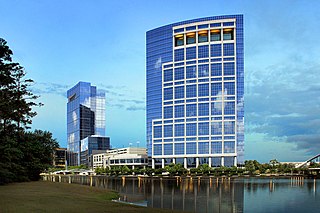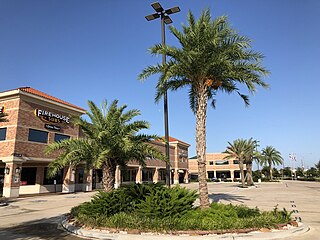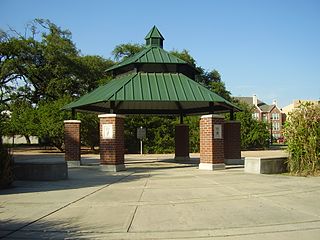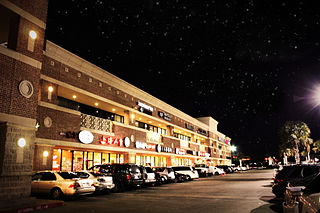Economy

By 2008 a Super H Mart supermarket, a part of a Korean American chain, opened in Spring Branch. Purva Patel of the Houston Chronicle wrote that this supermarket attracted development to the area. [9]
| Part of a series on |
| Ethnicity in Houston |
|---|
|
As of the 2010 U.S. Census there were 11,813 ethnic Koreans in Harris County, Texas, in the Houston area, making up 4.2% of the county's Asian population. [1] In 2015 Haejin E. Koh, author of "Korean Americans in Houston: Building Bridges across Cultures and Generations," wrote in regards to the census figure that "community leaders believe the number is twice as large." [2]
In 1970 the official census figure for people of Korean origins in the entire state was 2,090. Bruce Glasrud, a historian, stated that the real figure may be higher as some previous Korean immigrants were counted as Japanese, as Korea was then under the Empire of Japan. [3] Kristopher "Kris" Ahn, who immigrated to Houston in 1975, recalled that, at that time, there was one travel agency and grocery store each operated by ethnic Koreans in Houston and that a cohesive Korean ethnic community had not yet formed. [4] Gigi Lee, another immigrant in that era, stated that her family went to a store owned by ethnic Japanese people to get ethnic Korean products, and that the ethnic Korean community at the time numbered about 500. [5] Dr. Sam Jae Cho also stated that in the early 1980s that a Korean community had not yet solidified, and that a Korean church had a relatively small meeting area. [6]
As of 1983 there were about 10,000 ethnic Korean people in Houston. [7] In 1990 there were 6,571 ethnic Koreans, making up 6% of the county's Asian population. In 2000 this figure had increased to 8,764, making up 4.5% of the county's Asian population. The number of Koreans increased by 35% from 2000 to 2010. [1] In 2008 the estimated number of ethnic Koreans, which were about 5% of all persons of Asian origin in the area, was about 15,000. [8] The heads of area ethnic Korean organizations estimated that the population was around 30,000. [9]
In 2018 older ethnic Koreans protested against plans to include North Korea in Olympic ceremonies. [10]
Spring Branch has a large ethnic Korean population, [11] and therefore it houses multiple Korean businesses and institutions. [12]

By 2008 a Super H Mart supermarket, a part of a Korean American chain, opened in Spring Branch. Purva Patel of the Houston Chronicle wrote that this supermarket attracted development to the area. [9]
Circa 2011 there are about twenty ethnic Korean organizations in the Houston area. [13] They include Korean American Society of Houston (KASH), the Korean American Association of Houston (KAAH), [2] the Korean American Chamber of Commerce (KAAC), the Korean Student Associations (KSA) at the University of Houston (UH), [4] and the Korean-American Energy Exploration and Production Society. The Korean-American Scientists and Engineers Association also maintains a chapter for South Texas. [6]
The KAAH uses Korean as its primary medium on its website and in operations as most of its members are first generation immigrants. [4] The predecessor of KASH, Korean American Young Professionals Association (KAYPA), was established in 1985 with John H. Kim (born 1959 in Austin, Texas) as the first president. [2] The KAAC, established in 1974, [4] originally was Korean-medium. [5] Kris Ahn, who became the KACC president in 1995, perceived it and another organization as cannibalizing one another's purposes. Haejin Koh, wrote that "sustaining both organizations would be difficult and perhaps unnecessary." [4] Kris Ahn made English the primary medium of the KAAC, and Haejin Koh wrote that "In 2006 the two organizations came to serve separate constituencies and flourished." [5]
The Korean Community Center of Houston (KCCH), which occupies a 16,000-square-foot (1,500 m2) two story building in Spring Branch formerly used for medical offices, held its formal opening ceremony on March 12, 2011. $500,000 was spent for acquisition and $900,000 for renovation, [13] and the government of South Korea, the City of Houston, and ethnic fundraising provided money for this purpose. [5] Prior to the opening of the center, a house in Spring Branch was used as a community center. [14] The ethnic fundraising for such a center began around 1976 and in 2009 area Korean organizations made a drive to have the center established. [13] The building was put up for sale after Hurricane Ike had damaged it. [14] The storm damage increased the necessary costs of renovation. The Korean School, Seoul Baptist Church of Houston, local fundraising, ethnic Koreans in other countries, and seed money made up $100,000, $120,000, $200,000, $200,000, and $300,000, respectively. A U.S. Department of Housing and Urban Development grant worth $500,000 also supported the building. [13] The Korean Cultural Center, the Korean School, and the KAAH offices are in the building. [5]
Hyunja Norman created a political advocacy organization for Korean Americans, Woori Juntos, which was in existence by 2020. The name includes the Korean and Spanish names for the English word "we". [15]
There is also a Korean Senior Center. [8]
The Houston Korean School (휴스턴한인학교), located in the community center, provides supplementary Korean education. [5] In 2011 it was the first and largest tenant in the community center, and it had 175 students that year. [13] The Korean school previously held classes at a church. [6] There the Houston Community College (HCC) also has a facility, [5] where it holds English as a second language (ESL) classes. As of 2011 [update] an after school program was planned. [13]
As of 2011 [update] about 200 students at HCC were South Korean citizens. [16]
KASH organizes the Korean Festival (K-Fest), held every year at Discovery Green in Downtown Houston. It originated as the "Kimchi Fest", spearheaded by the KACC, in 2007. It received its current name in 2009 and expanded its scope. [5] K-Fest includes K-Pop, [17] Korean dance, Korean food, [18] American-Korean fusion food, taekwondo, and other Korean cultural performances. [17]
In 2018 Harris County did not offer Korean translations of election ballots. The office of the Harris County Clerk chose not to allow volunteer Korean translators inside polling places, citing state law, although they were allowed in the parking lot. [19]
In 2021 the Texas Legislature redrew U.S. House of Representatives boundaries so that the Korean community in Spring Branch was divided between two different districts, reducing their political representation. [20]

As of 2008 [update] the oldest ethnic Korean church is the Korean Christian Church of Houston. In September 2007 Chul Chung, the senior pastor, returned to South Korea after he resigned. In 2008 there was discord among factions in the church and around 100 people were expelled from the church. The members who were suspended or expelled instead attended services at the Korean Senior Center. [8]
In 1999 the Houston area had over 1,000 Korean Catholics. The Korean Catholic church is St. Andrew Kim Catholic Church in Spring Branch, named after Andrew Kim Taegon. [21] Seoul Baptist Church of Houston is an ethnic Baptist church in the area. [13]
On December 25, 2001, the Korean Community Church in The Woodlands, with Presbyterian Korean-language services and non-denominational English services, opened. It opened to serve ethnic Koreans in The Woodlands, Conroe, Huntsville, Kingwood, and Spring. [22]
In May 2014 Korean Air started a flight from Incheon International Airport near Seoul to George Bush Intercontinental Airport. [23] The KACC supported this effort. [5] The airline canceled the service in 2017, stating that there was not enough demand for the flight. [24]

Sienna, formerly known as Sienna Plantation, is a census-designated place and master-planned community located in Fort Bend County, Texas, United States. It is mostly in the extraterritorial jurisdiction (ETJ) of Missouri City with the remainder in the ETJ of Arcola. The population was 20,204 at the 2020 census, up from 13,721 at the 2010 census.

Spring Valley Village is a city in Harris County, Texas, United States, and an enclave of Houston. The population was 4,229 at the 2020 U.S. census.

The Woodlands is a special-purpose district and census-designated place (CDP) in the U.S. state of Texas in the Houston–The Woodlands–Sugar Land metropolitan statistical area. The Woodlands is primarily located in Montgomery County, with portions extending into Harris County. The Woodlands is governed by The Woodlands Township, an organization that provides municipal services and is administered by an elected board of directors. As of the 2020 U.S. Census, the township had a population of 114,436 people.

Katy is a city in the U.S. state of Texas. It is in the Greater Katy area, itself forming the western part of the Greater Houston metropolitan area. Homes and businesses may have Katy postal addresses without being in the City of Katy. The city of Katy is approximately centered at the tripoint of Harris, Fort Bend, and Waller counties. The population was 21,894 at the 2020 census.

Chinatown is a community in Southwest Houston, Texas, United States.

Spring Branch is a district in west-northwest Harris County, Texas, United States, roughly bordered by Tanner Road and Hempstead Road to the north, Beltway 8 to the west, Interstate 10 to the south, and the 610 Loop to the east; it is almost entirely within the city of Houston. Established by the Texas Legislature, the Spring Branch Management District exercises jurisdiction over the area.
Alief is a working-class suburb in Southwest Harris County, Texas, United States. Most of Alief is within the city limits of Houston, while a portion of the community is in unincorporated Harris County.

In the U.S. state of Texas, Houston is the largest city by both population and area. With a 1850 United States census population of 2,396—and 596,163 a century later, in 1950—Houston's population has experienced positive growth trends. In 2000, the city had a population of 1,953,631 people in 717,945 households and 457,330 families, increasing to 2,304,580 at the 2020 census.
Greater Katy Area is the term often used to refer to a suburban region on the west side of the Greater Houston metropolitan area roughly corresponding to the boundaries of the Katy Independent School District. Many people and businesses in this area have a Katy address, but are not part of the city of Katy. This area includes the suburbs that surround the Katy city limits west to Pederson road, roughly east to State Highway 6, north to FM 529, and south to FM 1093/ Westpark Tollway Parkway. While these boundaries are not exact, it gives a rough outline of what most people consider Greater Katy, and what the USPS designates as "Katy, Texas" by assigning that city to addresses within zip codes that fall in this region. Most of Greater Katy is to the east of the city of Katy toward Houston and includes surrounding suburban areas and unincorporated areas that are not in the Houston city limits. The region includes parts of Harris County, Fort Bend County, and Waller County much as the City of Katy does. Greater Katy is one of the fastest-growing portions of the Houston metropolitan area and the state of Texas as a whole.

Houston Community College (HCC), also known as Houston Community College System (HCCS), is a community college system that operates community colleges in Houston, Missouri City, Greater Katy, and Stafford in Texas. It is notable for actively recruiting internationally and for the large number of international students enrolled, over 5,700 in 2015. Its open enrollment policies, which do not require proficiency in English, are backed by a full-time 18-month English proficiency program and remedial courses.

This article discusses the history of Vietnamese Americans and Vietnamese immigrants in Houston, Texas, and its environs. Vietnamese immigration has occurred in Greater Houston, including Fort Bend County and Harris County, since 1975, after the Vietnam War ended and refugees began coming to the United States.

The Houston area population includes a large number of people with Chinese ancestral backgrounds. According to the American Community Survey, as of 2013, Greater Houston has 72,320 residents of Chinese origin.
As of the 2020 there were approximately 70,814 Korean-origin people in Illinois, with the vast majority in the Chicago metropolitan area. This makes Illinois the state with the eighth-largest Korean American population and the Chicago metropolitan area the fifth-largest, after Los Angeles, New York, Washington, and Seattle. As of 2006 the largest groups of Koreans are in Albany Park, North Park, West Ridge, and other communities near Albany Park. Many Koreans have since moved to northern and northwestern Chicago suburbs, including Glenview, Morton Grove, Mount Prospect, Niles, Northbrook, Schaumburg, and Skokie. A Koreatown, labeled "Seoul Drive", exists along Lawrence Avenue between Kedzie Avenue and Pulaski Road, albeit in diminished form. There were a number of Korean businesses on Clark Street in the 1970s, in Lakeview and Lincoln Park.
Throughout its history the city of Houston, Texas has been religiously influenced by Protestant Christianity in the Bible Belt. Since the latter half of the 20th century, the Houston area has become home to many different religions in part to its large ethnic diversity, immigration, and refugee resettlement.

Christianity is the most widely practiced religion in the city of Houston, Texas. In 2012, Kate Shellnutt of the Houston Chronicle described Houston as a "heavily Christian city". Multiple Christian denominations originating from various countries are practiced in the city; among its Christian population, the majority are either Catholic, Baptist, or non/interdenominational.
This article discusses Japanese Americans and Japanese citizens in Houston and Greater Houston.
Dallas–Fort Worth is the most populous metropolitan area of Texas, and the Southern United States. Having 7,637,387 residents at the 2020 U.S. census, the metropolitan statistical area has experienced positive growth trends since the former Dallas and Fort Worth metropolitan areas conurbated into the Metroplex. By the 2022 census estimates, its population grew to 7,943,685.
The Boston metropolitan area has an active Korean American community. The largest groups of Koreans in Massachusetts in 2000 were in Boston, Brookline, Cambridge, Newton, and Somerville.
The Hispanic population in Houston is increasing as more immigrants from Latin American countries come to work in the area. As of 2006 the city has the third-largest Hispanic population in the United States. As of 2011, the city is 44% Hispanic. As of 2011, of the city's U.S. citizens that are Hispanic, half are age 18 or older, and are therefore at the age range eligible to vote. As of 2011 many Hispanics in Houston are not U.S. citizens, especially those living in Gulfton and Spring Branch, and are therefore ineligible to vote in elections. As a result, Hispanics have proportionally less representation in the municipal government than other ethnic groups. As of April 2011 two of the Houston City Council members are Hispanic, making up 18% of the council.

Houston has large populations of immigrants from Asia. In addition, the city has the largest Vietnamese American population in Texas and third-largest in the United States as of 2004. Houston also has one of the largest Chinese American, Pakistani American, and Filipino American populations in the United States.
{{cite journal}}: Cite journal requires |journal= (help){{cite journal}}: Cite journal requires |journal= (help) - Profile